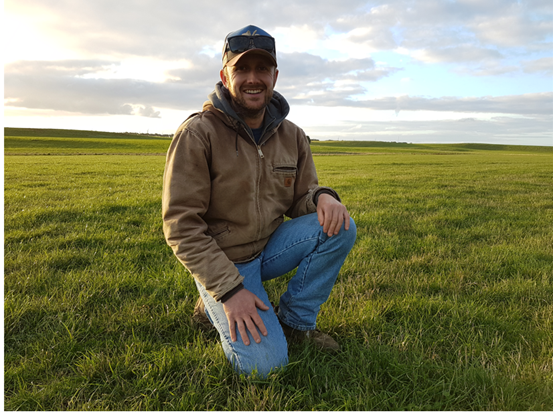 Simon Gabb shares his top tips for making the most of sub-clover pastures. Image: Jess Brogden.
Simon Gabb shares his top tips for making the most of sub-clover pastures. Image: Jess Brogden.
Sub-clover pastures set up high spring performance
For western Victorian brothers Simon (pictured) and Alistair Gabb, good sub-clover pastures allow them to turn off lambs earlier, restore ewe condition score sooner and gain access to several markets.
The high quality spring pastures they need to achieve this are developed by maximising leaf growth over winter.
Grazing pressure for great pasture
Every year, Simon and Alistair build a feed wedge before winter lambing starts on 24 June.
At the point of lambing, they aim to have 1,500kg DM/ha of food on offer and stock anywhere from 8–13 ewes to the hectare. By spring, most of the pastures are getting down to 1,000kg DM/ha or even less.
This high grazing pressure over winter works in favour of sub-clover, reducing shading by taller grasses while the heavy grazing creates more leaves to ensure flowering and seed set is maximised in spring.
“The more grazing pressure you put on the sub-clover through that late winter to spring period, the more leaves it makes and more points for flowering,” Simon said.
“We don't want it to get to 2,000kg DM/ha, we aim to keep it at 1,000 to 1,500.
“Even with that in mind, 1,500kg DM/ha of sub-clover is a lot of feed for lambs – it's lush, high protein, very palatable and digestible.
“For paddocks that have a sub-clover base in them, the high grazing pressure is actually allowing the sub-clover to perform.
“We know that once we pull the stock off those paddocks at the start of spring the sub-clovers will really take off,” Simon said.
High intensity, high growth management
To manage the potentially high growth rates of spring pastures, Simon boxes mobs of ewes and lambs and implements high intensity grazing over short periods.
“Once we can safely move ewes and lambs around or after lamb marking, we'll start to box up ewes into larger mobs to increase grazing intensity and start to spell paddocks,” Simon said.
“Preferably, we'll spell the sub-clover paddocks and we’ll spell them as early as possible to let the sub-clover put on a lot of growth, so we can wean lambs onto them in early to mid-October.
“We’re also conscious of flowering –each paddock has multiple varieties of sub-clover with different maturing dates, so the reduced weaner stocking pressure allows the sub-clover to flower, seed and bury burr without it being eaten.
“Maintaining some stock to graze also encourages the sub-clover to bury the seed under the ground rather than leave it on top,” Simon said.
Clover content for saleable lambs
On Simon and Alistair’s property, the lamb growth rates required to meet market requirements are achieved by having pastures composed of up to 70% sub-clover content.
“Sub-clovers paddocks are always prioritised for our saleable lambs, so the ewes don’t graze these,” Simon said.
“As soon as lambs are weaned, ewes are turned out onto grass dominant pastures – they don't need the high crude protein, energy is all they need.
“I like to average a daily gain of 350 grams, so basically from birth, we want our lambs to be achieving 300 grams a day then increasing this as their age increases.”
The first saleable wether lambs leave the farm in early to mid-October as 35kg store lambs. The remainder of the lambs are grown out to 50kg liveweight, targeting domestic markets. Only a portion of ewe lambs are retained as self-replacements, with surplus ewes sold on as future breeders.
Pasture for profit
Simon said sub-clovers are a proven performer in putting on kilograms per hectare.
“That is ultimately the reason why we focus a lot of attention on our sub-clovers and ensure that they perform like we need them to.
“The economics just stack up.”
|
Lessons learned
|



